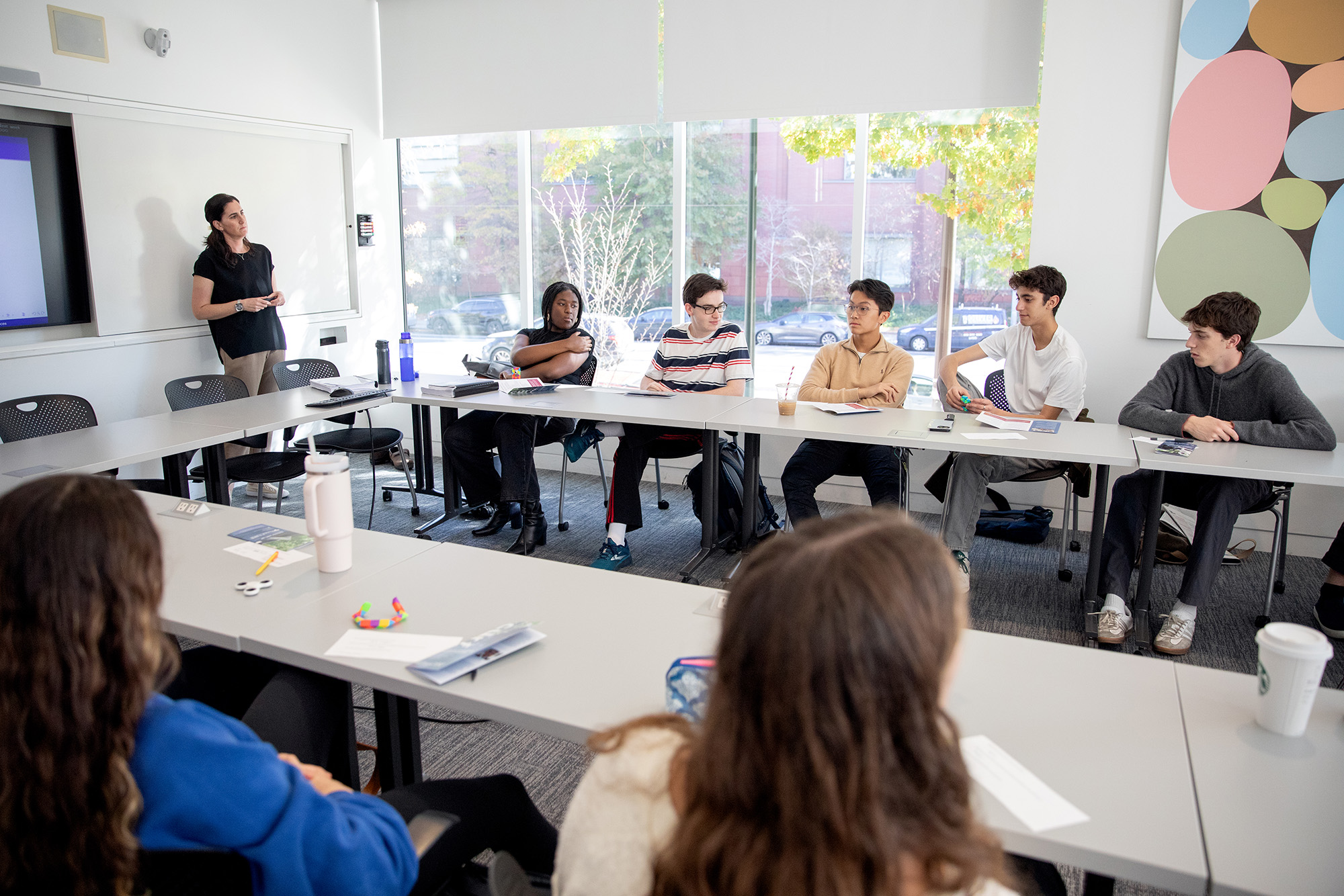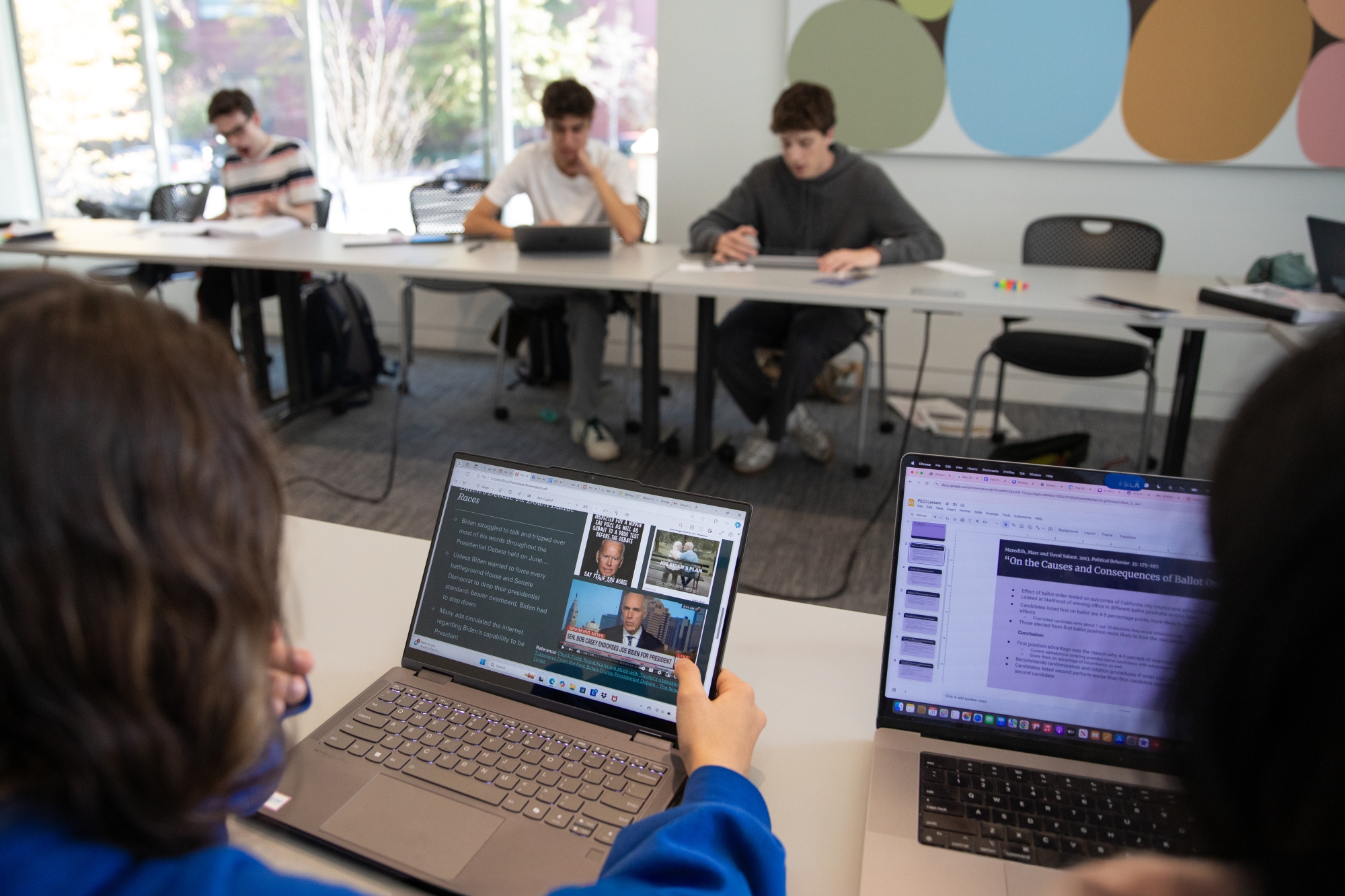Who “won” the presidential debate? Is there such a thing as too much democracy? Should we trust the electoral process? These are some of the questions Michele Margolis, an associate professor of political science, has asked her students to consider in her currently underway first-year seminar. Like many topics in this highly contentious election season, they would seem likely to be divisive, or at least to cause heated discussion.
And that’s partly the point.
The class, Decision 2024: Following and Understanding the Presidential Election, is one of 60 first-year seminars offered this fall through the College of Arts & Sciences that help new undergraduates connect with Penn and learn about a wide variety of topics. This year, 10 of these courses are part of a pilot that teaches students how to have respectful dialogue around difficult subjects, conversations facilitated by the professor and an undergraduate “learning assistant” who knows the professor well.
Students in Margolis’s class are learning how to use the theories and findings of political science to understand the nuances and implications of this year’s election. The course covers voting behavior, polling, electoral integrity, political strategies, media coverage, the impact of social media, and other key facets of this process.
“Political science can tell us a lot about elections before they happen,” says Margolis. “We have literature about the role that the media plays, the role of new media, how gender and race matter, how religion matters, how geography matters. I’m focusing on teaching the students to see the current landscape through the lens of accumulated knowledge that we’ve gained over 50 years of research.”
Students began the class with different levels of background knowledge, so Margolis helped fill in the gaps—about the electoral college or the concept of federalism, for example—as quickly as possible so the class could “move on to the more interesting conversations and get a better understanding of what’s going on out there,” she says.
Those conversations might have turned confrontational, especially since, as Margolis notes, “we have a mix of students politically—it’s definitely not a liberal or conservative bubble.” Yet she has been impressed at how well her students have talked about divisive topics like reproductive rights and January 6 in a respectful and constructive manner. “It seems they had already internalized concepts like disagreeing with the idea, not the person,” she says.
Though first-year seminars are intentionally small—typically no more than 15 students per class—that might still be too large for an anxious student to feel inclined to participate. That’s where the learning assistant for this class, Vincent Lepani, C’25, can help create a more organic conversation, Margolis says. “Sometimes we split the class in half and other times we’ll have three or four students in a group on their own and go around and visit with them. That can feel like a safer place—the stakes are lower.”
Lepani, who took Introduction to American Politics and is currently taking Political Psychology with Margolis, participated in training from Penn’s Paideia Program and the Office of Inclusion to learn how to lead dialogue on difficult issues. “If things ever start to go badly in a discussion, I have the tools to handle it and bring the conversation back on topic,” he says. “It’s about making sure that you’re being sensitive to all the different identities in the room and that what you’re saying is appropriate and you’re not harming anybody in those conversations.”
The structure of the class helps keep the conversation productive, too, says Margolis. “We’re reading the academic literature, so it’s not just about your opinion but how you think about the election or these voting behaviors or these campaign strategies in light of what the literature says, for example, about our natural biases to want to vote for people who look like us or how faith plays a role.”
We have a mix of students politically—it’s definitely not a liberal or conservative bubble. It seems they had already internalized concepts like disagreeing with the idea, not the person.
Cole Pryor, W’28, points to a recent moment when the class analyzed the effect of religion on politics and explored how members of different religious groups typically vote. “The point of these discussions is neither to come to a consensus nor to determine a ‘right’ or ‘wrong’ view,” he says. “Rather, they are meant to encourage us to reflect on our own experiences and those of our classmates, helping us develop nuanced perspectives on challenging issues.”
Another discussion focused on whether political polarization is good for the country, recalls Molly Lang, C’28. “While the class was definitely split into two distinct sides, we were able to keep our discussion from becoming heated by reminding ourselves to stay respectful, remembering that everyone comes from different backgrounds with different experiences.”
To that end, early in the semester, Margolis asked her students to reflect on their own political backstories and which parts of their identity, upbringing, or experiences have shaped how they see the political world. She also had them take a political perception gap quiz to find out how their views compared to others who share the same party affiliation and how their perceptions (or misperceptions) of the other party compared to members of that party’s actual opinions.

Leading up to the presidential election, conversations have touched on subjects from the impact of race, ethnicity, and gender on the election to the students’ own political backstories. After the election, the remaining classes will focus on trust in the electoral process and what our future political environment will look like as young people get older and America becomes more diverse.
Before discussing the impact of race, ethnicity, and gender on the election, Margolis’s students took an implicit association test designed to reveal hidden or subconscious biases. Through this exercise, she says, “students were confronted with biases they didn’t know they had—such as equating men with careers and women with family—and by reflecting on the results, they came to a better understanding of why they see the world the way they do.”
Students have also dug into election-related topics from multiple vantage points—reading newspaper articles and blogs, watching TV segments, going down social media rabbit holes—from both left- and right-leaning sources, and then talked about them with a classmate. The point was to learn what the other person’s opinions were and why they held them, as well as where they tended to get their information. They were also asked to reflect on the media’s overall influence.
Given that this is the first presidential election many of these students will participate in, having these conversations and considering all the different factors is important, Lepani says. “Making sure they have a really solid foundation will help them be more informed, not only for this election, but for all elections they’ll vote in throughout their lives.”
Beyond what Pryor has learned about political science and elections, he says the course has been eye opening. “Growing up,” he says, “I was taught that it was taboo to talk about politics. Now I realize it’s important to have these kinds of conversations as it encourages us to think deeply not just about our own opinions, but about the ever-changing political landscape as a whole.”
Post Election Day, the remaining classes will focus on trust in the electoral process—do Americans trust it? What would make someone less likely to trust it?— and what our future political environment will look like as young people get older and America becomes more diverse. Whatever the election’s outcome, one thing seems clear: there will still be plenty of timely and tricky topics to discuss.






